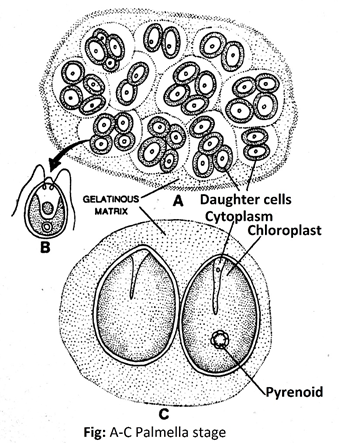Kingdom : Plantae
Division : Chlorophyta
Class : Chlorophyceae
Order : Volvocales
Family : Chlamydomonadaceae
Genus : Chlamydomonas
(Gr. Chlamys, mantle; monas, single organism)

Fig: Chlamydomonas
OCCURRENCE:
It is widely distributed unicellular algae. It is found in standing water of ponds, pools, ditches and on moist soil. A few members are present in sea.
STRUCTURE OF CHLAMYDOMONAS:
It is a unicellular alga. Each cell is oval, spherical, oblong or pyriform (pear shape).
Cell wall:
It is thin and occasionally possesses an outer thin mucilage sheath. It is cellulosic in nature and also contains hemicellulose and glycoproteins.
Flagella:
The two anterior flagella are present near the pointed end. These flagella arise from two basal granules called blepharoplast. The flagella are whiplash type.
Contractile vacuoles:
Two contractile vacuoles are present in each cell. Their main function is osmoregulation
Chloroplast:
A large cup-shaped chloroplast is present in cell. It contains matrix called stroma.
Pyrenoid: Pyrenoid consists of a central protein body surrounded by numerous minute starch grains. The number of pyrenoids is variable in different species. There may be two to any or no pyrenoid at all.
Eye spot:
An orange-red pigment spot or eye-spot (stigma) is present near the origin of flagella. This is sensitive to light. Therefore, it directs the movement of the individual.
Nucleus: All species are uninucleate and nucleus is present in the centre of cytoplasm.
REPRODUCTION:
Both asexual and sexual reproductions takes place in Chlamydomonas.

Fig: Zoospore formation in Chlamydomonas
ASEXUAL REPRODUCTION
Asexual reproduction takes place by the following methods:
- Zoospore formation:
Zoospores are formed under favourable conditions.
- The cells discard their flagella and become quiescent (non-motile). The contractile vacuoles also disappear.
- Its protoplast divides longitudinally into two halves. It is followed by a simultaneous division of each daughter protoplast.
- Nucleus is also divided into many pieces.
- Each nucleus is surrounded by cytoplasm and wall formation occurs.
- Two flagella appears in each cell.
- 2-16 zoopores are produced in each parent cell.
- Zoopores are released by rupturing cell wall and develop into new cells.
- Aplanospore formation:
Aplanospores are formed under dry conditions. Aplanospores germinate directly or divide to produce zoospores on the approach of favourable conditions.
- Palmella stage:
- It is formed under dry conditions.
- The daughter cells formed by the division, remain embedded inside the parent cell.
- The parent wall as well as the walls of daughter cells becomes mucilaginous.
- A large number of small non-motile cells are formed within an amorphous colony.
- This temporary stage is known as the palmella stage.
- The daughter cells develop flagella and become motile. Sometimes, cells develop into thick walled
These are red coloured due to the presence of a red pigment called the haematochrome.
- The spores release and develop into new individuals

Fig: Plamella stage of Chlamydomonas

Fig: life cycle of chlamydomonas
SEXUAL REPRODUCTION:
The sexual reproduction may be isogamy to anisogamy and oogamy.
At the time of sexual reproduction, the protoplast of a cell divides into 16, 32 or even 64 biflagellate gametes. The gametes may be naked called gymnogametes or they may be enclosed in a cell wall called calyptogametes.
- Isogamy: The gametes are naked, motile and equal in size. It occurs in reinhardi.
- Anisogamy: The gametes are motile but different in size. The female cell produces four larger Themale cell produces eight smaller microgametes. It occurs in C. monocia, C. braunii etc.
- Oogamy: The gametes are different both in size and shape. It occurs in corcifera and C. oogonium. The female cell functions as oogonium.It produces a large macrogamete or egg. The male cell functions as antherozoid. It produces 8, 16 or 32 small spherical biflagellate microgametes or sperms.
Fertilization:
The flagella disappear during fertilization. The quadriflagellate zygote may remain motile for more than
fifteen days. Then it secretes a wall and becomes zygospore.
Germination of Zygospore:
- The zygote becomes red as the chlorophyll is masked by haematochrome.
- Zygote divides by meiosis and four haploid cells are formed.
- Each cell is metamorphosed into a biflagellate zoospore.
- The parent wall of zygote is ruptured, and zoospores are liberated into water.